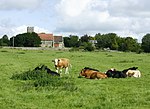Chalcot House
Country houses in WiltshireGeorgian architecture in WiltshireGrade II* listed buildings in WiltshireGrade II* listed housesPages containing links to subscription-only content ... and 2 more
Use British English from December 2020Wiltshire building and structure stubs
Chalcot House is a Grade II* listed country house to the south of the village of Dilton Marsh, near Westbury, Wiltshire, England, standing in Chalcot Park.
Excerpt from the Wikipedia article Chalcot House (License: CC BY-SA 3.0, Authors).Chalcot House
Chalcot Lane,
Geographical coordinates (GPS) Address Nearby Places Show on map
Geographical coordinates (GPS)
| Latitude | Longitude |
|---|---|
| N 51.2383 ° | E -2.2263 ° |
Address
Chalcot Lane
Chalcot Lane
BA13 4AB , Dilton Marsh
England, United Kingdom
Open on Google Maps







